In dogs, East West is an umbrella term that refers to any external rotation of the thoracic limb that results in the toes facing outward. Nebulous… My favorite. Given that there are several distinct postural deviations that cause the toes to face outward, I wanted to cover each, and discuss…
1. Where in the canine anatomy the East West / lateral rotation is stemming from.
2. Help you identify which one your pup might have.
3. Discuss what might be done to improve this postural deviation.
Type 1: True East West / External Shoulder Rotation
In dogs, this East West deviation is sometimes referred to as ‘elbows turned in’ or ‘loose elbows’. But this postural deviation is not technically related to the elbow at all. The elbow is a hinge joint. It does not rotate. Instead, this East West deviation comes from a lateral or outward rotation of the humerus at the level of the shoulder joint. As the proximal humerus rotates laterally, the distal humerus and antebrachium rotate medially. As a result, this postural deviation can be easily identified by a narrowness between the elbows and antebrachium shown in the photo below.

This is the result of an imbalance in the rotator cuff muscles. Mainly the external shoulder rotators are pulling too much, while the internal shoulder rotators are not pulling enough. This rotator cuff imbalance can be caused by a general lack of conditioning, repetitive type movement without cross training in work or sport, or as the result of a sprain / strain type injury and the resulting pain avoidance.
Unlike humans, the dog lacks a functional collarbone. Because of this, the shoulder joint is stabilized by muscle, tendon and ligament only. Coupled with the fact that dogs already carry a majority of their body weight in the forehand, this makes muscle balance through the shoulder even more important to mitigating risk, and maintaining quality of life long term.
NOTE: There is a lot of mythos around “lack of chest”, “chest dropping” and “ribs springing” being the cause of this deviation. And there may be some peripheral correlation there between hormones, muscle mass, and muscle balance. But the ACTUAL cause of this deviation is an imbalance between the external and internal shoulder rotators.
Type 2: East West / Carpal Valgus
Carpal valgus is a lateral deviation of the paw, from the line of the radius / ulna at the level of the wrist (carpal abduction). Dogs with carpal valgus do not display the external shoulder rotation and resulting narrowness as described above, or the dwarf mutation / angular limb deformity covered below. Instead this East West deviation is localized to the level of the dog’s carpus or wrist joint. There are several progressive degrees of this deviation ranging from mild to severe.

There are three main causes of this specific carpal valgus postural deviation.
1. Weakness in the musculature that supports the medial aspect of the carpus.
2. Damage to the musculature that supports the medial aspect of the carpus, like partial or full rupture of the carpal adductor muscles.
3. Premature closure of the growth plate due to genetics or growth plate injury.
There are some studies that claim a slight carpal valgus *may* improve sport performance, and results from intentional breeding. But I find that hard to believe given the extreme forces born by the carpal joint during sports and work. Any structural weakness in the kinetic chain needs to be absorbed by the neighboring links… Increasing the risk of repetitive overuse type injury to the digits, elbow and shoulder.
Type 3: East West / Angular Limb Deformity
All chondrodystrophic or dwarf breeds are all affected by some degree of angular limb deformity. This is the result of intentionally breeding the genetic mutation that produces short limbs… which create the breeds’ unique look and function. These genetics cause a premature closure of the distal ulnar growth plate, and a length discrepancy between the radius and ulna, resulting in the East West appearance through the forelimbs of dwarf breeds. As with any genetic trait, this postural deviation can be seen with more mild or more severe characteristics.
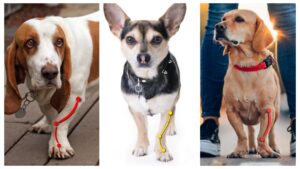
It should be noted that trauma-induced premature growth plate closure (damage to the distal ulnar or distal radial growth plate) can occur in dogs of any breed that have not reached skeletal maturity. And malunion fractures can occur in dogs of any age. So there are occurrences of this type of East West deviation outside dwarf breeds as well.
If you think your dog has a genetic or injury based ALD, you might find this article in dvm360 informative.
So what can we do to help dogs with East West Deviation?
The first step is identifying which specific deviation your pup is displaying, and getting checked out by a rehab professional or sports medicine vet to ensure the postural deviation is not the result of a past or current injury. True East West / External Shoulder Rotation and Carpal Valgus deviations are likely to be improved by targeted strengthening exercises.
Exercises for East West: External Shoulder Rotation
The following exercises help to address the strength and mobility discrepancy between the muscles in the rotator cuff. In all of these exercises, we are looking for the upper and lower forelimb to demonstrate less external rotation over time. These exercises may have prerequisites, all of which are listed at the bottom of each video tutorial.
Exercises for East West: Carpal Valgus
The following exercises help to strengthen the musculature on the medial aspect of the carpus. These exercises may have prerequisites, all of which are listed at the bottom of each video tutorial.
Dig Dig activates the caudal thoracic chain which runs along the back portion of the thoracic limb. These muscles have a primary action of carpal flexion, but also support the medial aspect of the carpus and assist in carpal adduction.
In the following exercise, we will leverage the shape of the PawPod to create a carpal bias, which re-aligns the paw, allowing the medial carpal stabilizers to work and strengthen.
Running in sand or gravel, or feeding from an elevated feeder are often suggested activities to help ‘fix” carpal valgus. And while there may be some mild positive changes attributed to these methods, this is not the best approach. We know from human physical therapy and fitness modalities, that implementing targeted exercise that produces neuromuscular re-education is far superior, faster and more effective long term. Teaching the dog to properly engage the deep and superficial digital flexors is the actual solution to the problem, and carries much less risk than running a dog repeatedly on gravel. For more on this topic, check out my blog post on neuromuscular re-education.
Exercises for East West: Angular Limb Deformity
Dogs with Angular Limb Deformity will also benefit from targeted conditioning exercises, but require a more customized approach, and will see best results by working with a credentialed fitness professional (CPCFT, CCFT, CSCC) or a credentialed rehab professional (CCRP, CCRT) to build a Custom Program.
Did you find this article helpful? Are you interested in learning more about common postural deviations and how conditioning can help? Let me know in the comments below! I want to write about the things you’re interested in!

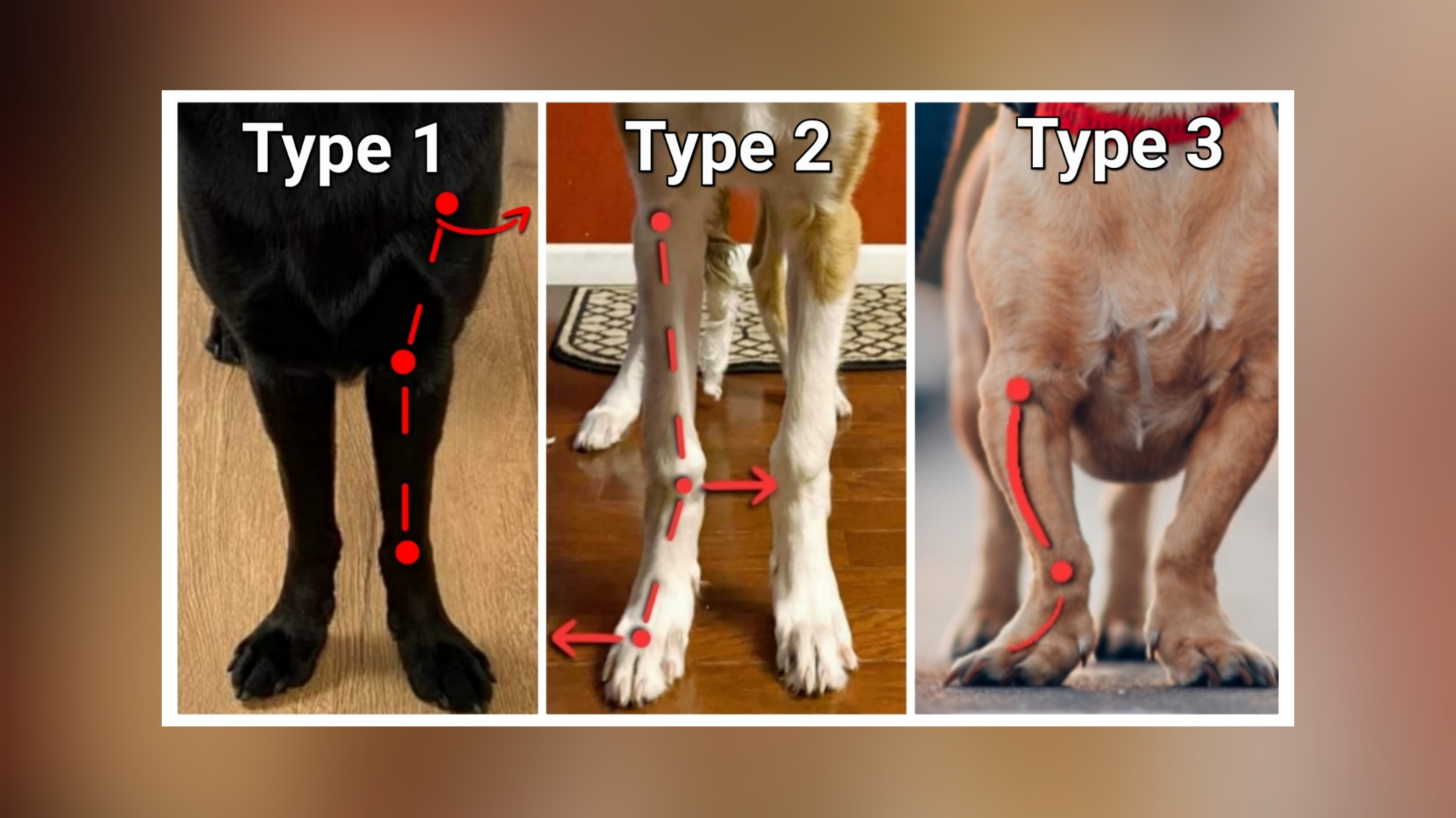
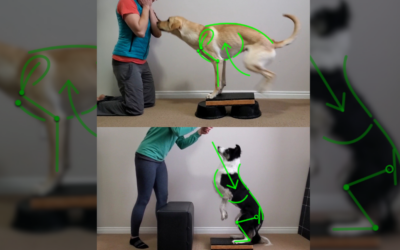
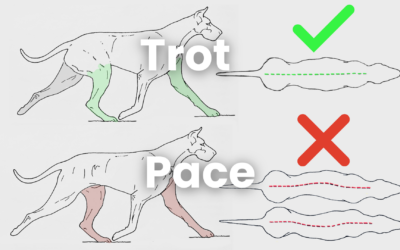
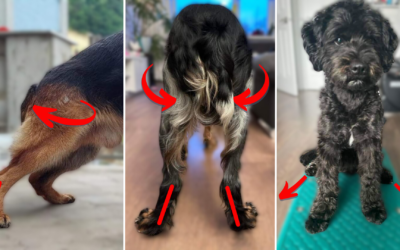
Thank you for Sharing this information!
Hey Andra!
You’re very welcome! I’m glad you found the information helpful!
I keep reading this and it seems to be the gift that keeps giving because I tend to learn something new when I revisit it. Thank you 🙂
I’m so glad to hear that Kristie! I know for myself, the more I learn… The more small nuggets I am able to pull from things I have learned in the past!